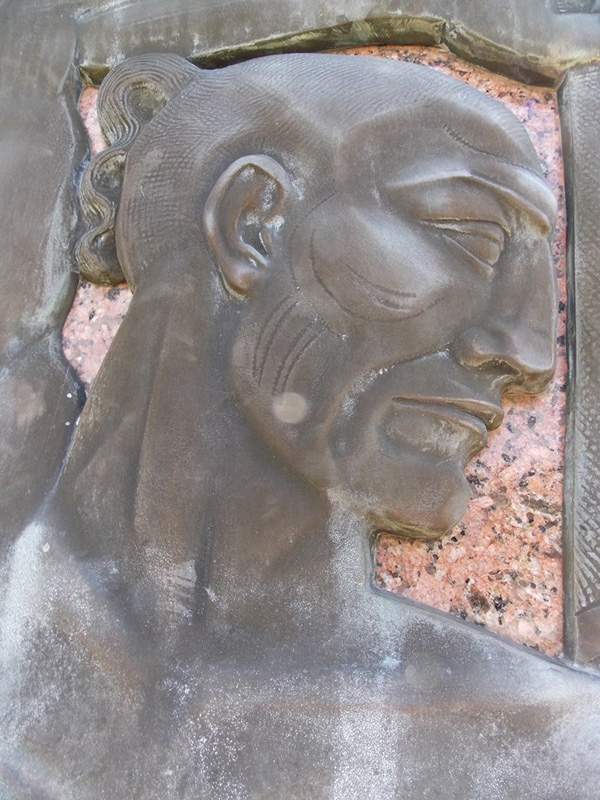It’s said that in terms of geological measurement, the existence of humanity is just a blink in the eye of time, that, roughly speaking, we emerged 300,000 years ago in Africa and appeared 30,000 years ago in North America, that recorded human history reaches back only 6,000 years, and that these stretches hardly punctuate a 4.5 billion-year planetary timeline. And yet, even in the blink of our existence, we still get things wrong or simply forget.
For instance, when you see the town of Spanish Fort on a Texas map, it jumps out at you. Not because it’s Spanish — we remember that the Spanish had forts in Texas. But this one is tucked into a long bend of the Red River, just north of Nocona, Texas, which is named after Quanah Parker’s father, Peta Nocona, husband of Cynthia Ann Parker and a giant Comanche chief who led his band of the tribe in innumerable raids across the Texas frontier from the 1830s to December 18, 1860, when he was slain at the Pease River in a battle with Capt. Lawrence Sullivan Ross. Cynthia Ann, who was “rescued” by Ross’ troops, was transported to remaining family in present-day Haltom City. She repeatedly attempted to escape back to her indigenous family. Quanah would go on to be the last great Comanche chief.
You know — or at least think you know — that the Spanish didn’t have any forts that far north in Texas, but you wonder if the structure is still intact. You may even consider why you’ve never heard of it before.
First, the fort, which included wooden stockades, entrenchments, and a moat (yes, a moat — in Texas) is long gone. A historical marker stands near the original location.
Second, “Spanish” fort is wholly inaccurate. The fortification was actually a French structure built at the location of a preexisting Taovaya Indian village around 1719. Yes, the French were in Texas 300 years ago. The Taovayas had just moved into the region when the French were beginning to venture farther west along the Red River, and the two peoples quickly became successful trading partners.
Third, when the only major defense of the fort was mounted in 1759, the attacking forces were actually Spanish and the fort defenders were a confederacy of almost entirely indigenous Taovaya, Wichita, and Comanche Indians. They were joined and at least rudimentarily trained by stragglers from the original French contingent. When an early Anglo settler visited the ruins 100 years later, he simply assumed they were Spanish, hence the town name of Spanish Fort.
And fourth, the Native American rout of the Spanish at the French Taovaya fortress marked Spain’s earliest defeat in Texas and probably kept them from expanding farther north.
In the mid-1750s, there were rumors of a lucrative silver-mining prospect near present-day Menard, and local Lipan Apache groups were reportedly interested in converting to Christianity. The Spanish established Mission San Saba and Presidio San Saba a few miles apart along the San Saba River to look into the silver claims and proselytize to the Apache. Not long after the two complexes were completed, the Apaches were boasting about their mighty new partners. When word of a new force in the region reached the Comanches, they marshaled some of their Wichita, Taovaya, and Yojuane allies and headed south. On the morning of March 16, 1758, the Comanche and their 2,000-warrior confederacy attacked the mission, massacred most of its inhabitants, and put most of the mission buildings under the torch. Reduced by various maneuvers in the area, the scantily numbered Spanish troops garrisoned at Presidio San Saba helplessly witnessed the upstream smoke and gunfire.
The enraged Spanish immediately commissioned Presidio San Saba commandant Col. Diego Ortiz Parilla to visit the same death and destruction wrought at Mission San Saba upon the Comanche and their allies. Parilla took a contingent of approximately 600 Spaniards, militiamen, and Lipan Apaches northward, proceeding west of the lower Cross Timbers to the Red River and then traveling east. On October 7, they discovered an old fortification flying the French colors on the Red River. It was protected by a tributary moat and — to the Spaniards’ surprise and wonderment — manned by Taovaya, Wichita, and Commanche Indians armed with French muskets.
Parilla’s Apaches attempted to cross the tributary but couldn’t. Parilla then brought up two canons. For four hours, Parilla bombarded the fort but with little effect. And during that period, the Spanish were constantly fired upon from the palisaded fortress stockades and attacked on all sides by opportunistic waves of Indian infantry and cavalry. By nightfall, the Spanish verged on being overrun, so they retreated, hastily leaving their supply train and cannons behind.
It took Parilla’s disgraced soldiers 18 days to return to Presidio San Saba, and the Comanche harassed them all the way. The Spanish never sought further military redress and soon abandoned the San Saba mission and presidio. Within a decade, there was no European influence left in the Spanish Fort area, but in 1771, the lieutenant governor of Spanish Louisiana normalized relations with the Taovaya settlement there via treaty and named it San Teodoro. The Taovayas were decimated by smallpox in the early 1800s and abandoned San Teodoro shortly thereafter.
The Comanche remained a force on the Texas plains until the late 19th century. The ranks of the Taovaya Indians shrank, and they eventually folded in with the Wichitas.
Today, all that remains of their fortified defense against and subsequent defeat of the Spanish is a historical marker mounted on an 8-foot tall shaft of red granite in the town square and the Taovayas Indian Bridge across the Red River, connecting Texas FM 677 to OK-89. Spanish Fort is still worth a visit because it will probably never make it into Lone Star State textbooks. Texas memory is primarily reserved for Anglo conquest.
Fort Worth native E. R. Bills is the author of Texas Obscurities: Stories of the Peculiar, Exceptional and Nefarious.
This column reflects the opinions and fact-gathering of the author and not the Fort Worth Weekly. To submit a column, please email Editor Anthony Mariani at Anthony@FWWeekly.com. He will gently edit it for clarity and concision.












